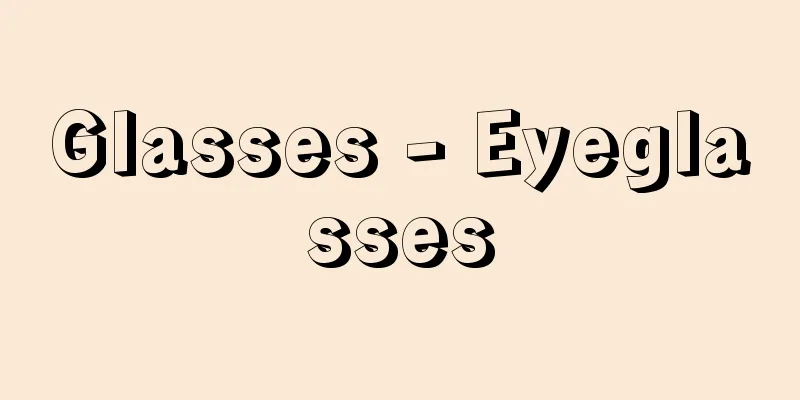Glasses - Eyeglasses

|
They are lenses worn in front of the eyes and are also called "reading glasses." People with normal vision start to need reading glasses from the age of 40, and in Japan, myopia is very prevalent due to environmental and genetic factors, so it is said that about one-third of Japanese people wear glasses regularly. In other words, reading glasses are the most widely used medical device. [Akira Nakajima] Types of glassesIn addition to so-called eyeglasses (corrective eyeglasses) used to correct refractive errors such as myopia, hyperopia, and astigmatism, or vision disorders such as presbyopia, there are also sunglasses to protect against ultraviolet rays, goggles to protect against the wind, and protective eyeglasses to keep dust out of the eyes or to serve both purposes. Lenses used in eyeglasses are made of plastic as well as glass. Although glass lenses have been designed to be lighter and have anti-reflective surfaces, they are still fragile and heavy, so plastic eyeglass lenses have become more common. Furthermore, the drawback of plastic lenses, that they are easily scratched, is being solved by technological advances in surface treatment. Glass lenses can also take on a color in a short time in bright places and become transparent in dark places. There are also plastic lenses that have this function. Multifocal lenses are often used for presbyopia, and bifocal lenses are mainly used, with some having no boundary between near and far-sightedness. Because the area where you can see clearly is always narrow and distorted, even if the lenses themselves have been devised, there are still many aspects that users must get used to. Small, thin lenses that are placed in close contact with the eyeball to correct refractive errors are called contact lenses. [Akira Nakajima] Glasses prescriptionFirst, the naked eye visual acuity is measured, then the corrected visual acuity (the person's best visual acuity) is measured by changing the lenses while wearing the eye frame. The "power" of the lens used for vision correction is expressed in diopters (D) defined by the following formula.
[Akira Nakajima] Myopia correctionSpherical concave lenses of the appropriate degree are used. If the degree of myopia is not too strong, distant objects may be difficult to see, but close objects can be seen well. In this case, glasses are used only when looking at distant objects, and glasses are not required on a regular basis. Adults can wear glasses as needed, but children may not like to wear glasses, so proper guidance is required. As a rule of thumb, if the naked eye visual acuity is 0.6 or less, it is better to have glasses on hand and wear them at least when it is inconvenient. [Akira Nakajima] Hyperopia correctionSpherical convex lenses of the appropriate degree are used. Hyperopia makes the eyes tired easily because the eyes are constantly adjusting when looking at things, so even if the naked eye vision is good, it is better to wear them all the time. In addition, hyperopia can cause amblyopia or strabismus in children, so wearing them is necessary to treat these conditions. [Akira Nakajima] Correcting astigmatismCylindrical lenses are used. In cases of severe astigmatism that cannot be corrected with glasses, or irregular astigmatism caused by irregularities in the surface of the cornea, contact lenses may be necessary. Generally, everyone has some astigmatism, but when it becomes severe, symptoms similar to eye strain, such as eye pain, headaches, and a heavy feeling in the head, are experienced even when adjusting the eyes, and in such cases, proper correction is necessary. [Akira Nakajima] Reading GlassesIn addition to the three types of glasses mentioned above, there are also the commonly known reading glasses. The eyes have a function called accommodation, which allows the eyes to focus when looking at objects. This is done by changing the thickness of the crystalline lens using the ciliary muscle to focus on the object being viewed. This elasticity of the crystalline lens is sufficient when we are young, but it is lost as we reach middle age. As a result, it becomes difficult to see objects up close with normal vision, which is the beginning of presbyopia. The power of accommodation is expressed in diopters, which are the lens power that determines the range in which objects can be seen clearly. This power decreases with age, and is said to be 3 diopters at 42 or 43 years old. At 50 years old, it is 2 diopters, and at 60 years old, the power of accommodation is no longer there, and presbyopia does not progress beyond this. It is a good idea to have glasses made and wear them as needed. [Akira Nakajima] Lens typeSpectacle lenses are divided into three types according to refractive power: weak, medium, and strong. As the refractive power increases, the weight increases, but convex lenses are thinner at the periphery and concave lenses are thinner at the center. After cataract surgery, the lens is generally corrected using a strong convex lens because the crystalline lens has been removed. The stronger the power, the worse the resolution at the periphery of the lens, so to compensate for this drawback, lenses with aspheric surface curves have been developed. Prism lenses are used to correct heterophoria. In other words, when using binocular vision, the left and right lines of sight must be focused on the same place, and if there is heterophoria (latent strabismus), the direction of the misalignment of the lines of sight can cause eye strain and headaches. Prisms are used to correct this misalignment and fuse the images of both eyes. In addition, there are special color lenses called polarized lenses, which weaken the reflected light on the surface of water and snow, making them ideal lenses for fishermen and skiers. Plastic lenses can be dyed to create a wide range of colors and half colors. With the advent of contact lenses and intraocular lenses, the use of strong eyeglasses has decreased. [Akira Nakajima] Frame typeGlasses frames can be broadly classified by material into plastic frames, metal frames, tortoiseshell frames, and combination frames. Plastic frames include celluloid, acetate, and epoxy resin. Metal frames include precious metals such as gold, platinum, white gold, gold-plated, and gold-plated, and base metals such as titanium, sun platinum, nickel-chrome, stainless steel, and nickel silver. Tortoiseshell frames are made by gluing together the shells of hawksbill sea turtles, which live near the equator, but their use is restricted to protect resources. Combination frames are metal frames with plastic or other materials partially attached to them. [Akira Nakajima] [Reference items] | | | | | |Source: Shogakukan Encyclopedia Nipponica About Encyclopedia Nipponica Information | Legend |
|
眼前に装用するレンズで、「がんきょう」ともいう。正視では40歳を過ぎたころから老眼鏡が必要になるし、また日本は環境因子や遺伝因子などの関係から近視が非常に多いこともあり、日本人の約3分の1は眼鏡を常用しているといわれる。いうならば、いちばん多く使われている医療器具ともいえる。 [中島 章] 眼鏡の種類近視、遠視、乱視などの屈折異常、あるいは老視といった視力障害を補正する目的で使用する、いわゆる眼鏡(矯正眼鏡)のほかに、紫外線を防ぐ目的のサングラスをはじめ、風よけのゴーグルや、目にごみなどが入らないようにするために用いたり、それらを兼用する保護眼鏡もある。また、眼鏡に用いるレンズには、ガラスのほかにプラスチックがある。ガラスについては、重さを減らしたり、表面の反射防止などのくふうもなされてきたが、どうしても壊れやすかったり重かったりするため、プラスチック製眼鏡レンズが普及してきた。さらに、プラスチックレンズの欠点であった傷がつきやすいということも、表面処理の技術進歩で解決されつつある。また、ガラスレンズでは、明るいところで短時間のうちにレンズに色がつき、暗いところで透明になるといったものもできている。プラスチックレンズでもこのような機能をもったものがある。老視いわゆる老眼の場合によく使われるのが多重焦点レンズで、おもに二重焦点レンズが使われ、遠用と近用のレンズの境目のないものもある。はっきり見える部分がどうしても狭かったり、ゆがんで見えたりするために、レンズそのもののくふうはされても、結局現在のところ、使う側で慣れなければならないところが多分にある。なお、眼球に密着(コンタクト)させて目の屈折異常を矯正する、小さくて薄いレンズをコンタクトレンズという。 [中島 章] 眼鏡の処方まず裸眼視力を測定し、引き続き検眼枠を装用してレンズをいろいろかえ、矯正視力(その人のもっともよい視力)を測定する。視力矯正に用いたレンズの「度」は、次式で定義されるジオプトリー(D)で表す。
[中島 章] 近視の矯正適当な度の球面凹レンズが使われる。近視の度がそれほど強くない場合は遠いところは見えにくくても近くはよく見えるので、このような場合は遠いところを見るときだけ眼鏡を使用して、普段はかけなくてもよい。大人の場合は必要に応じてかければよいが、子供では眼鏡をかけたがらない場合もあり、正しい指導が必要である。いちおう、裸眼視力が0.6以下のときは眼鏡を用意し、不便なときだけでも装用したほうがよい。 [中島 章] 遠視の矯正適当な度の球面凸レンズが使われる。遠視では物を見るとき、つねに調節しているため疲れやすく、裸眼視力がよくても、つねに装用していたほうがよい。また、子供では遠視が原因で弱視や斜視になる場合もあるので、その治療を含めて装用が必要になる。 [中島 章] 乱視の矯正円柱レンズが使われる。眼鏡で矯正できないほどの強い乱視や、さらに角膜表面の凹凸不正が原因である不正乱視では、コンタクトレンズを装用しなくてはいけない場合がある。一般には、だれでも多少の乱視はあるが、程度が強くなると、目の調節によっても眼痛、頭痛、頭重感などいわゆる眼精疲労のような症状を訴えるので、このようなときには正しい矯正が必要である。 [中島 章] 老眼鏡以上3種類の眼鏡のほかに、一般によく知られている老眼鏡がある。目には物を見るとき焦点をあわせるための調節という働きがある。これは毛様体筋によって水晶体の厚さを変えることにより、見ようとするものにピントをあわせる。この水晶体の弾力性が、若いときは十分あっても、中年になると年とともに失われてくる。そのため正視では近くが見えにくくなる、つまり老眼の始まりである。調節力は、物がはっきり見える範囲をレンズの度であるジオプトリーで表すが、年齢とともに小さくなり、42、3歳は3ジオプトリーといわれている。50歳で2ジオプトリー、60歳で調節力はなくなり、それ以上は老視は進まない。必要に応じて眼鏡をつくり、装用するのがよい。 [中島 章] レンズの種類眼鏡レンズは屈折力によって、弱屈折、中屈折、強屈折の3種類に分けられる。屈折力が大きくなるにつれて重さは増すが、凸レンズは周辺部の厚さが薄くなり、凹レンズは中心厚が薄くなる。白内障手術後のレンズとしては、水晶体が摘出されているため、一般に強度の凸レンズを用いて矯正する。度数が強くなればなるほどレンズ周辺部の解像力が悪くなるので、その欠点を補うため、レンズの表面カーブに非球面を用いたレンズも開発されている。斜位の矯正にはプリズムレンズが用いられる。すなわち、両眼視をする際、左右の視線を同一箇所に集める必要があり、斜位(潜伏斜視)があると、視線のずれの方向によって眼精疲労や頭痛を引き起こす。このずれを矯正するのにプリズムを用い、両眼の像の融合を図るものである。また、特殊カラーレンズに偏光レンズがあり、水面や雪面の反射光を弱めるので、釣り師やスキーヤーに最適のレンズである。プラスチックレンズは染色により豊富な色彩やハーフカラーをつくることができる。コンタクトレンズ、眼内レンズが実用になって、度の強い眼鏡の使用は減った。 [中島 章] フレームの種類フレーム(眼鏡枠)を素材で分類すると、プラスチック枠、金属枠、べっこう枠、コンビネーション枠に大別される。プラスチック枠には、セルロイド、アセテート、エポキシ樹脂などがある。金属枠には、金、プラチナ、ホワイトゴールド、金張り、金めっきなどの貴金属製枠と、チタン、サンプラチナ、ニッケルクロム、ステンレス、洋白などの卑金属製枠がある。べっこう枠は、赤道付近に生息するタイマイというウミガメの甲らを張り合わせてつくるが、資源保護のため使用が制限されている。コンビネーション枠は、金属枠にプラスチックなどの別素材を一部取り付けた枠である。 [中島 章] [参照項目] | | | | | |出典 小学館 日本大百科全書(ニッポニカ)日本大百科全書(ニッポニカ)について 情報 | 凡例 |
>>: Meghadūta (English spelling)
Recommend
Fuchino Basin - Fuchino basin
A basin in the Apennine Mountains in central Italy...
Orientalism; Oriental Studies
A general term for academic studies that focus on ...
Chitragupta
… Yama, the Indian god of death, governs the unde...
Hydration - Suiwa
Generally, it refers to a chemical species (ion, ...
Neuroblastoma
…This generally follows a course similar to acute...
Zinc flower
A common name for zinc oxide as an industrial che...
Schooner
...The classification of brigs, brigantines, and ...
Prometheus Desmotes - Bound Prometheus
A tragedy by the great Greek tragic poet Aeschylu...
Shishido clan
A powerful clan in Hitachi and Aki provinces in th...
Shimokobe-so
A manor belonging to Emperor Hachijo in Katsushik...
Barid Shahi (English spelling)
...The first four kingdoms to gain independence w...
Elizabeth
She was the mother of John the Baptist and a relat...
Kalimba (English spelling)
An African folk instrument. It has a resonating bo...
Nguyen Phi Khanh - Nguyen Phi Khanh
...Vietnamese scholar and thinker in the early 15...
Babbling - What
〘noun〙① To talk at length. Also, to chatter away. ...









